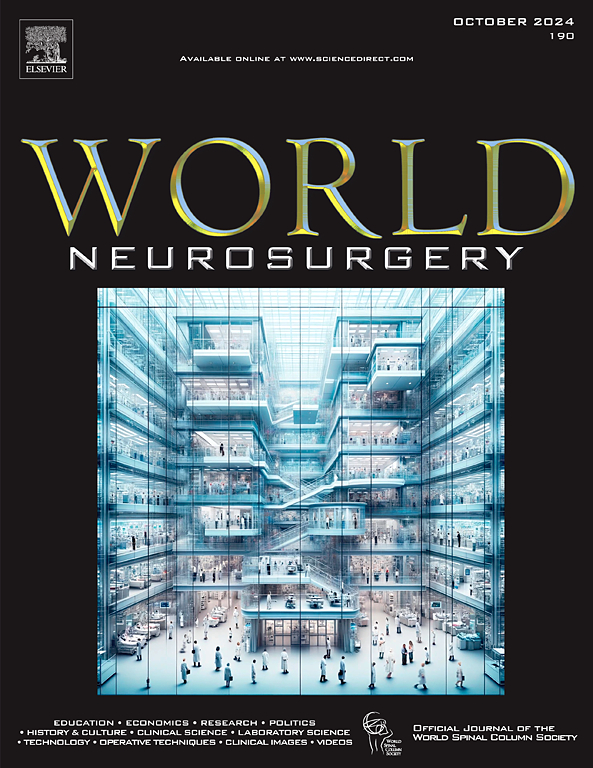Historical Review of Traumatic Brain Injury Caused by Fishing Speargun & a New Suicide Case
IF 1.9
4区 医学
Q3 CLINICAL NEUROLOGY
引用次数: 0
Abstract
Background
Traumatic brain injury (TBI) is a severe neurosurgical emergency and a significant public health concern. Fishing-speargun TBIs are included in nonmissile injuries and have been implicated in only few cases of TBI in the past 68 years, mainly of accidental etiology.
Objective
To introduce a novel case report of a TBI in a 38-year-old man who shot himself with a speargun in a suicide attempt and to present a thorough review of related case reports along with the management strategies, prognosis, and outcomes.
Methods
We conducted a literature review of case reports in accordance with the Preferred Reporting Items for Systematic Reviews and Meta-Analyses guidelines, including incidents of TBI by speargun published in PubMed, Scopus, and Web of Science until January 2024.
Results
A total of 22 publications, reporting 26 cases of speargun-related TBIs, formulated the 27 investigated cases including the current patient which were used in this descriptive and inferential statistical analysis. Predominantly affecting males (88.89%) with a median age of 29 years, these injuries were primarily due to accidents (65.38%), with a noticeable shift toward suicide. Outcome variability ranged from intact recovery (48.15%) in majority of cases to a range of unfavorable outcomes. Significant factors impacting outcomes included initial Glasgow Coma Scale score <8, major initial computed tomography head findings, and major complications. Survival analysis indicated early manifestation of unfavorable outcomes.
Conclusions
In summary, the diverse presentation, management, outcomes, and identified influencing factors highlight the complexity of managing speargun-related injuries, and the need for personalized approaches and further research to enhance care protocols.
文献综述:钓鱼矛枪造成创伤性脑损伤的历史回顾和一个新的自杀案例。
背景:创伤性脑损伤(TBI)是一种严重的神经外科急症,也是一个重大的公共卫生问题。捕鱼用矛枪造成的创伤性脑损伤属于非导弹伤害,在过去的 68 年中,只有极少数创伤性脑损伤病例与捕鱼用矛枪有关,主要是意外伤害:目的:介绍一例新的创伤性脑损伤病例报告,该病例是一名 38 岁的男子在自杀未遂时用鱼叉枪射伤了自己,并对相关病例报告以及处理策略、预后和结果进行了全面回顾:根据 PRISMA 指南,我们对截至 2024 年 1 月在 Pubmed、Scopus 和 Web of Science 上发表的病例报告进行了文献综述:共有 22 篇文献报道了 26 例与鱼叉枪有关的创伤性脑损伤,其中包括本例患者在内的 27 例调查病例,这些病例被用于描述性和推断性统计分析。这些创伤主要由意外事故造成(65.38%),但也有明显的自杀倾向。结果差异很大,从大多数病例的完全康复(48.15%)到一系列不利的结果。影响结果的重要因素包括最初的 GCS 评分结论:总之,不同的表现形式、处理方法、结果和已确定的影响因素凸显了处理鱼叉枪相关伤害的复杂性,以及采取个性化方法和开展进一步研究以加强护理规程的必要性。
本文章由计算机程序翻译,如有差异,请以英文原文为准。
求助全文
约1分钟内获得全文
求助全文
来源期刊

World neurosurgery
CLINICAL NEUROLOGY-SURGERY
CiteScore
3.90
自引率
15.00%
发文量
1765
审稿时长
47 days
期刊介绍:
World Neurosurgery has an open access mirror journal World Neurosurgery: X, sharing the same aims and scope, editorial team, submission system and rigorous peer review.
The journal''s mission is to:
-To provide a first-class international forum and a 2-way conduit for dialogue that is relevant to neurosurgeons and providers who care for neurosurgery patients. The categories of the exchanged information include clinical and basic science, as well as global information that provide social, political, educational, economic, cultural or societal insights and knowledge that are of significance and relevance to worldwide neurosurgery patient care.
-To act as a primary intellectual catalyst for the stimulation of creativity, the creation of new knowledge, and the enhancement of quality neurosurgical care worldwide.
-To provide a forum for communication that enriches the lives of all neurosurgeons and their colleagues; and, in so doing, enriches the lives of their patients.
Topics to be addressed in World Neurosurgery include: EDUCATION, ECONOMICS, RESEARCH, POLITICS, HISTORY, CULTURE, CLINICAL SCIENCE, LABORATORY SCIENCE, TECHNOLOGY, OPERATIVE TECHNIQUES, CLINICAL IMAGES, VIDEOS
 求助内容:
求助内容: 应助结果提醒方式:
应助结果提醒方式:


